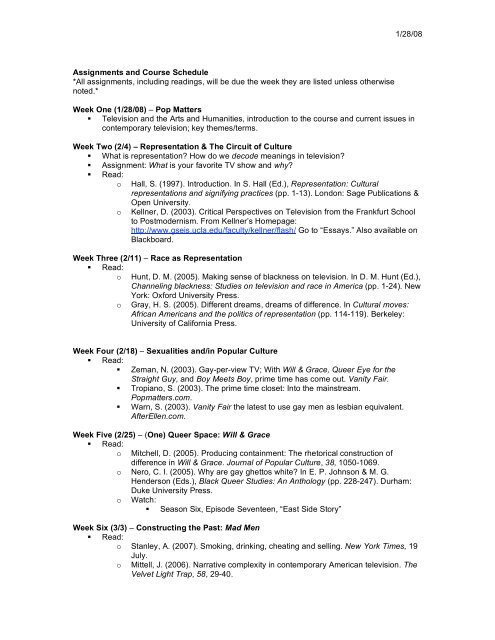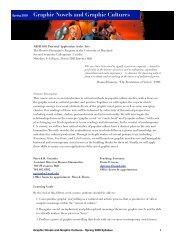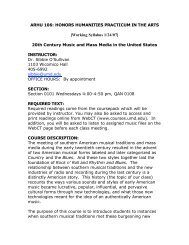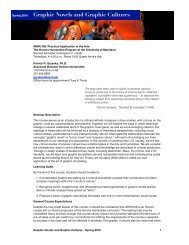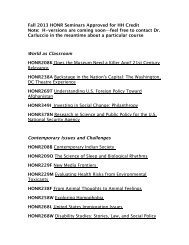Course Syllabus - Writing/Social Issues in Pop Culture (PDF) (2008)
Course Syllabus - Writing/Social Issues in Pop Culture (PDF) (2008)
Course Syllabus - Writing/Social Issues in Pop Culture (PDF) (2008)
You also want an ePaper? Increase the reach of your titles
YUMPU automatically turns print PDFs into web optimized ePapers that Google loves.
1/28/08<br />
Assignments and <strong>Course</strong> Schedule<br />
*All assignments, <strong>in</strong>clud<strong>in</strong>g read<strong>in</strong>gs, will be due the week they are listed unless otherwise<br />
noted.*<br />
Week One (1/28/08) – <strong>Pop</strong> Matters<br />
! Television and the Arts and Humanities, <strong>in</strong>troduction to the course and current issues <strong>in</strong><br />
contemporary television; key themes/terms.<br />
Week Two (2/4) – Representation & The Circuit of <strong>Culture</strong><br />
! What is representation? How do we decode mean<strong>in</strong>gs <strong>in</strong> television?<br />
! Assignment: What is your favorite TV show and why?<br />
! Read:<br />
o<br />
o<br />
Hall, S. (1997). Introduction. In S. Hall (Ed.), Representation: Cultural<br />
representations and signify<strong>in</strong>g practices (pp. 1-13). London: Sage Publications &<br />
Open University.<br />
Kellner, D. (2003). Critical Perspectives on Television from the Frankfurt School<br />
to Postmodernism. From Kellner’s Homepage:<br />
http://www.gseis.ucla.edu/faculty/kellner/flash/ Go to “Essays.” Also available on<br />
Blackboard.<br />
Week Three (2/11) – Race as Representation<br />
! Read:<br />
o Hunt, D. M. (2005). Mak<strong>in</strong>g sense of blackness on television. In D. M. Hunt (Ed.),<br />
Channel<strong>in</strong>g blackness: Studies on television and race <strong>in</strong> America (pp. 1-24). New<br />
York: Oxford University Press.<br />
o Gray, H. S. (2005). Different dreams, dreams of difference. In Cultural moves:<br />
African Americans and the politics of representation (pp. 114-119). Berkeley:<br />
University of California Press.<br />
Week Four (2/18) – Sexualities and/<strong>in</strong> <strong>Pop</strong>ular <strong>Culture</strong><br />
! Read:<br />
! Zeman, N. (2003). Gay-per-view TV; With Will & Grace, Queer Eye for the<br />
Straight Guy, and Boy Meets Boy, prime time has come out. Vanity Fair.<br />
! Tropiano, S. (2003). The prime time closet: Into the ma<strong>in</strong>stream.<br />
<strong>Pop</strong>matters.com.<br />
! Warn, S. (2003). Vanity Fair the latest to use gay men as lesbian equivalent.<br />
AfterEllen.com.<br />
Week Five (2/25) – (One) Queer Space: Will & Grace<br />
! Read:<br />
o<br />
Mitchell, D. (2005). Produc<strong>in</strong>g conta<strong>in</strong>ment: The rhetorical construction of<br />
difference <strong>in</strong> Will & Grace. Journal of <strong>Pop</strong>ular <strong>Culture</strong>, 38, 1050-1069.<br />
o Nero, C. I. (2005). Why are gay ghettos white? In E. P. Johnson & M. G.<br />
Henderson (Eds.), Black Queer Studies: An Anthology (pp. 228-247). Durham:<br />
Duke University Press.<br />
o<br />
Watch:<br />
! Season Six, Episode Seventeen, “East Side Story”<br />
Week Six (3/3) – Construct<strong>in</strong>g the Past: Mad Men<br />
! Read:<br />
o Stanley, A. (2007). Smok<strong>in</strong>g, dr<strong>in</strong>k<strong>in</strong>g, cheat<strong>in</strong>g and sell<strong>in</strong>g. New York Times, 19<br />
July.<br />
o Mittell, J. (2006). Narrative complexity <strong>in</strong> contemporary American television. The<br />
Velvet Light Trap, 58, 29-40.


